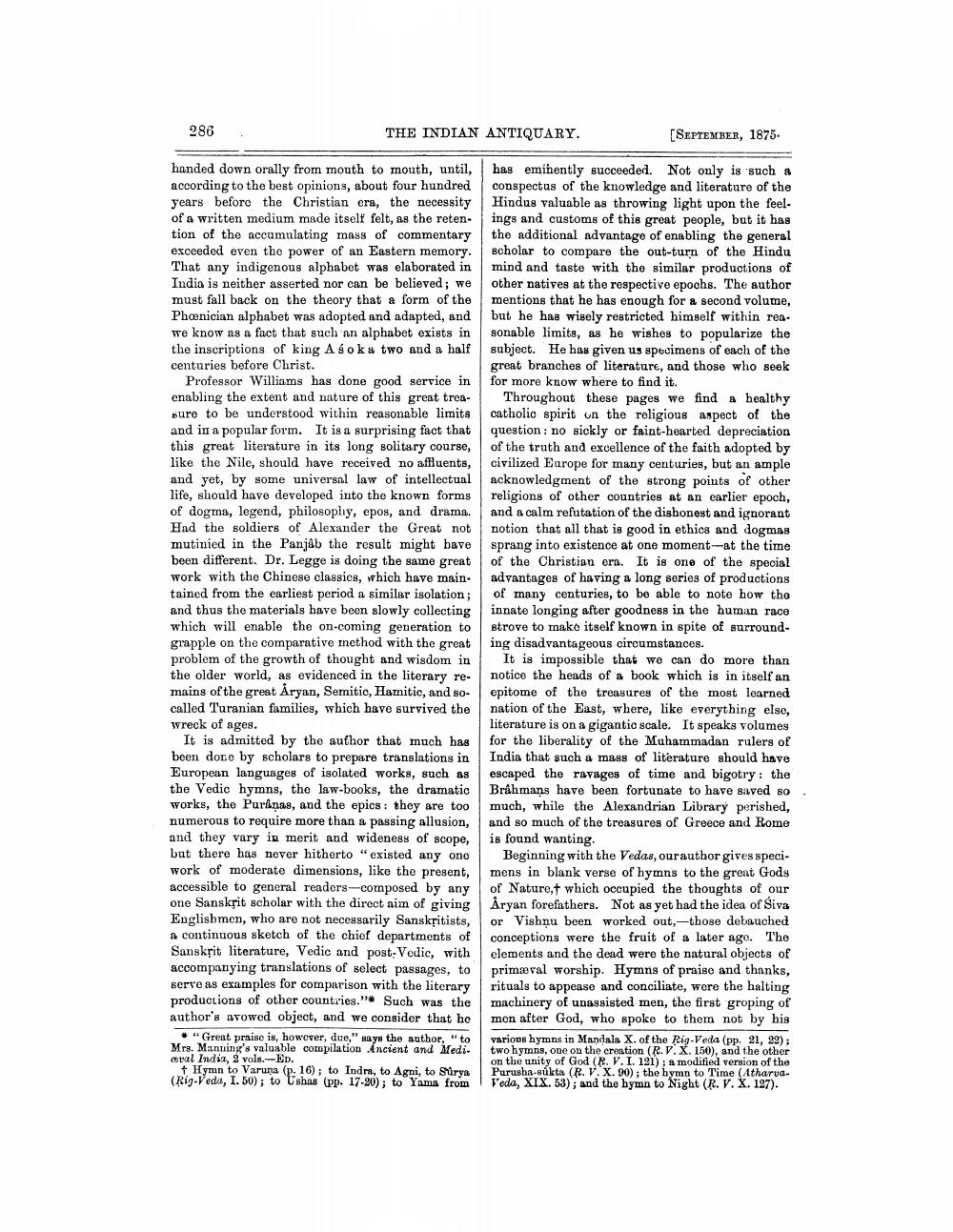________________
286
THE INDIAN ANTIQUARY.
handed down orally from mouth to mouth, until, according to the best opinions, about four hundred years before the Christian era, the necessity of a written medium made itself felt, as the retention of the accumulating mass of commentary exceeded even the power of an Eastern memory. That any indigenous alphabet was elaborated in India is neither asserted nor can be believed; we must fall back on the theory that a form of the Phoenician alphabet was adopted and adapted, and we know as a fact that such an alphabet exists in the inscriptions of king Asoka two and a half centuries before Christ.
Professor Williams has done good service in enabling the extent and nature of this great treasure to be understood within reasonable limits and in a popular form. It is a surprising fact that this great literature in its long solitary course, like the Nile, should have received no affluents, and yet, by some universal law of intellectual life, should have developed into the known forms of dogma, legend, philosophy, epos, and drama. Had the soldiers of Alexander the Great not mutinied in the Panjab the result might have been different. Dr. Legge is doing the same great work with the Chinese classics, which have maintained from the earliest period a similar isolation; and thus the materials have been slowly collecting which will enable the on-coming generation to grapple on the comparative method with the great problem of the growth of thought and wisdom in the older world, as evidenced in the literary remains of the great Åryan, Semitic, Hamitic, and socalled Turanian families, which have survived the wreck of ages.
It is admitted by the author that much has been done by scholars to prepare translations in European languages of isolated works, such as the Vedic hymns, the law-books, the dramatic works, the Puranas, and the epics: they are too numerous to require more than a passing allusion, and they vary in merit and wideness of scope, but there has never hitherto "existed any one work of moderate dimensions, like the present, accessible to general readers-composed by any one Sanskrit scholar with the direct aim of giving Englishmen, who are not necessarily Sanskritists, a continuous sketch of the chief departments of Sanskrit literature, Vedic and post-Vedic, with accompanying translations of select passages, to serve as examples for comparison with the literary productions of other countries." Such was the author's avowed object, and we consider that he
"Great praise is, however, due," says the author, "to Mrs. Manning's valuable compilation Ancient and Medieval India, 2 vols.-ED.
+ Hymn to Varuna (p. 16); to Indra, to Agni, to Surya (Rig-Veda, I. 50); to Ushas (pp. 17-20); to Yama from
[SEPTEMBER, 1875.
has eminently succeeded. Not only is such a conspectus of the knowledge and literature of the Hindus valuable as throwing light upon the feelings and customs of this great people, but it has the additional advantage of enabling the general scholar to compare the out-turn of the Hindu mind and taste with the similar productions of other natives at the respective epochs. The author mentions that he has enough for a second volume, but he has wisely restricted himself within reasonable limits, as he wishes to popularize the subject. He has given us specimens of each of the great branches of literature, and those who seek for more know where to find it.
Throughout these pages we find a healthy catholic spirit on the religious aspect of the question: no sickly or faint-hearted depreciation of the truth and excellence of the faith adopted by civilized Europe for many centuries, but an ample acknowledgment of the strong points of other religions of other countries at an earlier epoch, and a calm refutation of the dishonest and ignorant notion that all that is good in ethics and dogmas sprang into existence at one moment-at the time of the Christian era. It is one of the special advantages of having a long series of productions of many centuries, to be able to note how the innate longing after goodness in the human race strove to make itself known in spite of surrounding disadvantageous circumstances.
It is impossible that we can do more than notice the heads of a book which is in itself an epitome of the treasures of the most learned nation of the East, where, like everything else, literature is on a gigantic scale. It speaks volumes for the liberality of the Muhammadan rulers of India that such a mass of literature should have escaped the ravages of time and bigotry: the Brahmans have been fortunate to have saved so much, while the Alexandrian Library perished, and so much of the treasures of Greece and Rome is found wanting.
Beginning with the Vedas, our author gives specimens in blank verse of hymns to the great Gods of Nature, which occupied the thoughts of our Aryan forefathers. Not as yet had the idea of Siva or Vishnu been worked out,-those debauched conceptions were the fruit of a later age. The elements and the dead were the natural objects of primeval worship. Hymns of praise and thanks, rituals to appease and conciliate, were the halting machinery of unassisted men, the first groping of men after God, who spoke to them not by his various hymns in Mandala X. of the Rig-Veda (pp. 21, 22); two hymns, one on the creation (R. V. X. 150), and the other on the unity of God (R. V. I. 121); a modified version of the Purusha-súkta (R. V. X. 90); the hymn to Time (AtharvaVeda, XIX. 53); and the hymn to Night (R. V. X. 127).




